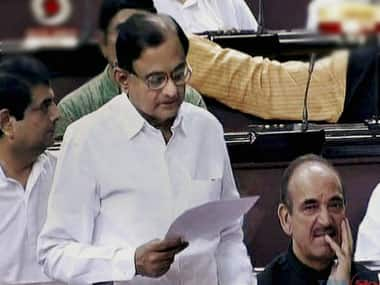Pranab Mukherjee thought three was his lucky number. In his 2011-12 budget speech, many of his schemes had allocations of Rs 300 crore, and Mukherjee explained why: “Hon’ble Members may be curious as to why all these new initiatives are being launched with an allocation of Rs 300 crore. Well, the number 3 happens to be my lucky number!”
While we leave it to readers to judge how lucky Mukherjee was with this number, the fact is the Indian economy did not find the number lucky.
Is double-three, or 33, a lucky number for his successor as finance minister, P Chidambaram? He is not known to believe in lucky charms or auspicious dates so there has to be a rational explanation for why he chose a 33-year period to work out the trend growth rate of the economy.
[caption id=“attachment_76607” align=“alignleft” width=“380”]
 Image from Rajya Sabha TV[/caption]
Image from Rajya Sabha TV[/caption]
To recap, in his budget speech, Chidambaram spoke about how the trend growth rate of the economy over 33 years has been 6.2 percent and that the average annual growth rate during the National Democratic Alliance regime had been less at 5.9 percent, while the same during UPA-1 and UPA-2 had been 8.4 percent and 6.6 per cent respectively. Actually, average annual growth during the NDA years was 6 percent.
But that’s a small quibble. What’s more interesting is to see why a 33-year period - 1981 to 2013 - was chosen by Chidambaram. A trend rate of growth is an average rate usually worked out over a fairly long period to even out the highs and lows of cyclical growth. There is no hard and fast rule to choose the first and the last years of any period that is chosen, the only caveat being that generally the first year and the last year of the period chosen should be “normal” growth years. That is no unusual drought or extraordinarily bountiful years.
Since 1991 has been a watershed year for the Indian economy, why didn’t Chidambaram choose that year to start a trend analysis? The trend growth for the period from 1991 to 2013 works out to 6.6 percent, which still shows the UPA performing better than the trend and the NDA lagging.
Could he have chosen 1981 because that this will give the longest period in which the NDA’s economic performance can be shown below the trend growth? Immediately on going beyond 1981, the trend growth dips below 6 percent and shows the NDA performance in better light.
If 1980 is also included, it brings down the trend growth to 5.7 percent. Growth had declined 5.2 percent that year because of a combination of the global oil shock in 1978-79, high rates of taxation by the Janata Party government and the political instability in the country. But since trend analysis do not start or end with abnormal years, it might be fair to add 1979 to the calculation. The trend growth then becomes 5.9 percent. The simple point is that the longer one goes back in history, the lower the trend growth happens to be and then the average annual growth rate of the NDA years betters the trend rate.
There could be some other, less political, reasons for choosing 1981. The pre-1980 period, points out Devendra Pant, chief economist, India Ratings, economic growth often fluctuated sharply between years. Growth in the 1980s and after is a bit stable. It was also from then that India broke out of the so-called “Hindu rate of growth” trap.
Two, this was the first year after Mrs Indira Gandhi’s return to power in 1980. But there perhaps was more than a routine genuflection to the dynasty here. It was during this period that the first tentative steps towards liberalisation of the economy began to be taken, something Rajiv Gandhi continued. The trend growth from 1985 onwards works out to 6.3 percent.
All this begs another question - when should one start assessing a particular government’s economic record measured in terms of growth rates? Normally it is from the end of the first financial year after it comes to power. Thus, the UPA’s report card starts with the 2004-05 growth rate of 7.1 percent and will end with the 2013-14 growth rate. But considering the first three months of a financial year are gone before a new government comes to power and it takes some time to settle in and get down to the task of managing the economy, can it really take the credit or blame for the way the economy grows in that year?
Before this is taken as an insidious attempt to take credit away from the UPA and give it to the NDA, let us consider the United Front government which came to power in June 1996 (end of the first quarter). Growth in 1996-97 was 8 percent. Should the credit for that really go to the UF, which was not a stable coalition by any stretch of imagination? Shouldn’t the credit of that really go to PV Narasimha Rao and Manmohan Singh who nurtured the economy from 1.4 percent growth in 1992 to 8 percent?
In any case, adding the 2004-05 growth figure to the NDA’s tally doesn’t alter the picture hugely. Its performance improves only marginally from 6 percent to 6.1 percent.
Instead of choosing to highlight the NDA’s poor performance, it might have been better for Chidambaram to explain why, under the UPA’s watch, an economy which recovered from the global meltdown of 2008 pretty quickly went into a freefall soon after?
Seetha is a senior journalist and author
)